Tassal Group: A Strategic Analysis of Market Entry into Japan
VerifiedAdded on 2023/04/04
|22
|4907
|484
Report
AI Summary
This report assesses the market potential for Tassal Group Limited's meat or seafood products in Japan. It includes a comprehensive company and product analysis, utilizing frameworks like PESTEL, competitor analysis, and buyer analysis to determine the most suitable country for international business expansion. The report justifies the selection of Japan based on comparative data and information, highlighting the market entry strategy. Key findings from the analysis are summarized to provide a concise overview of Tassal Group's strategic approach to entering the Japanese market.
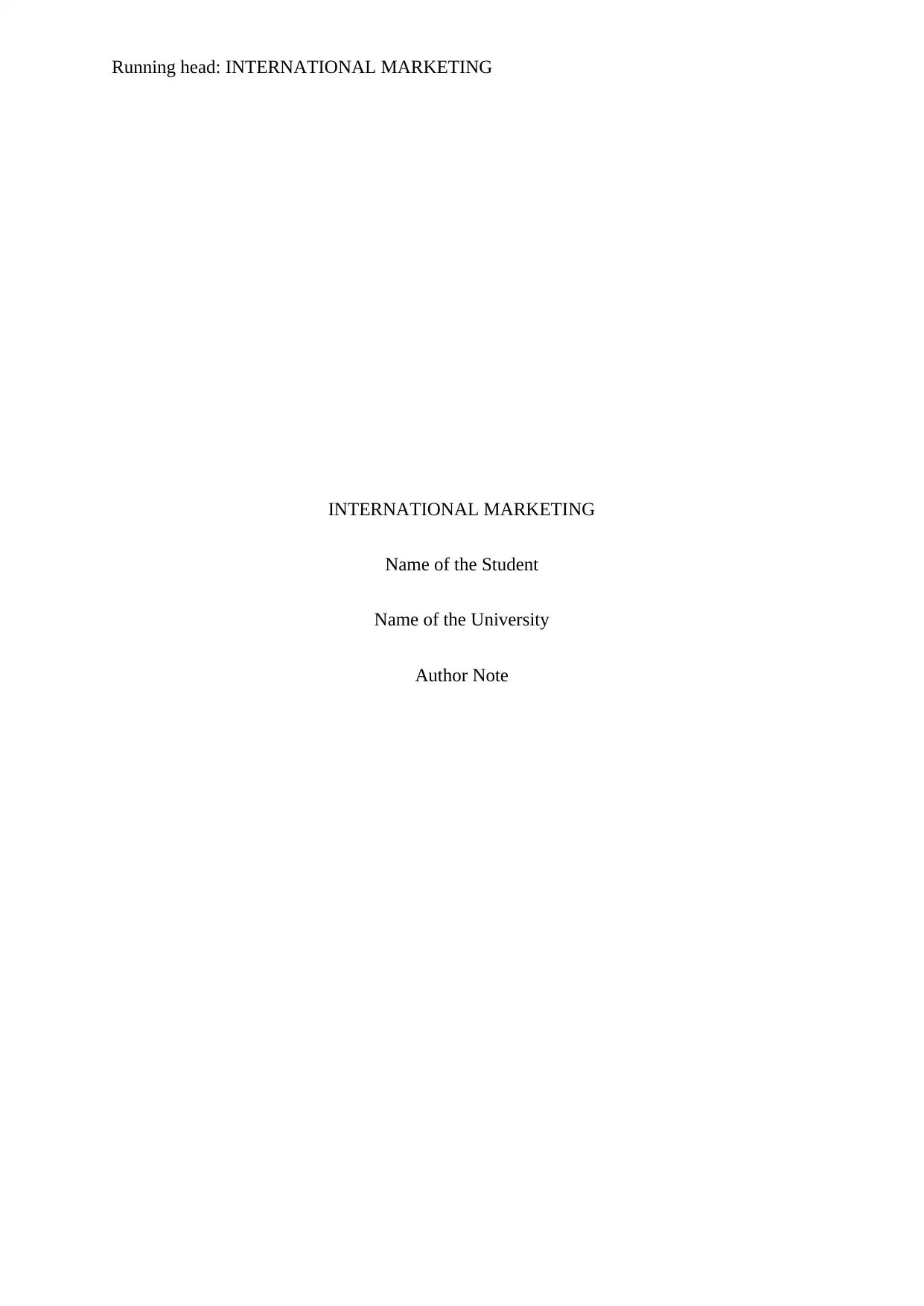
Running head: INTERNATIONAL MARKETING
INTERNATIONAL MARKETING
Name of the Student
Name of the University
Author Note
INTERNATIONAL MARKETING
Name of the Student
Name of the University
Author Note
Paraphrase This Document
Need a fresh take? Get an instant paraphrase of this document with our AI Paraphraser
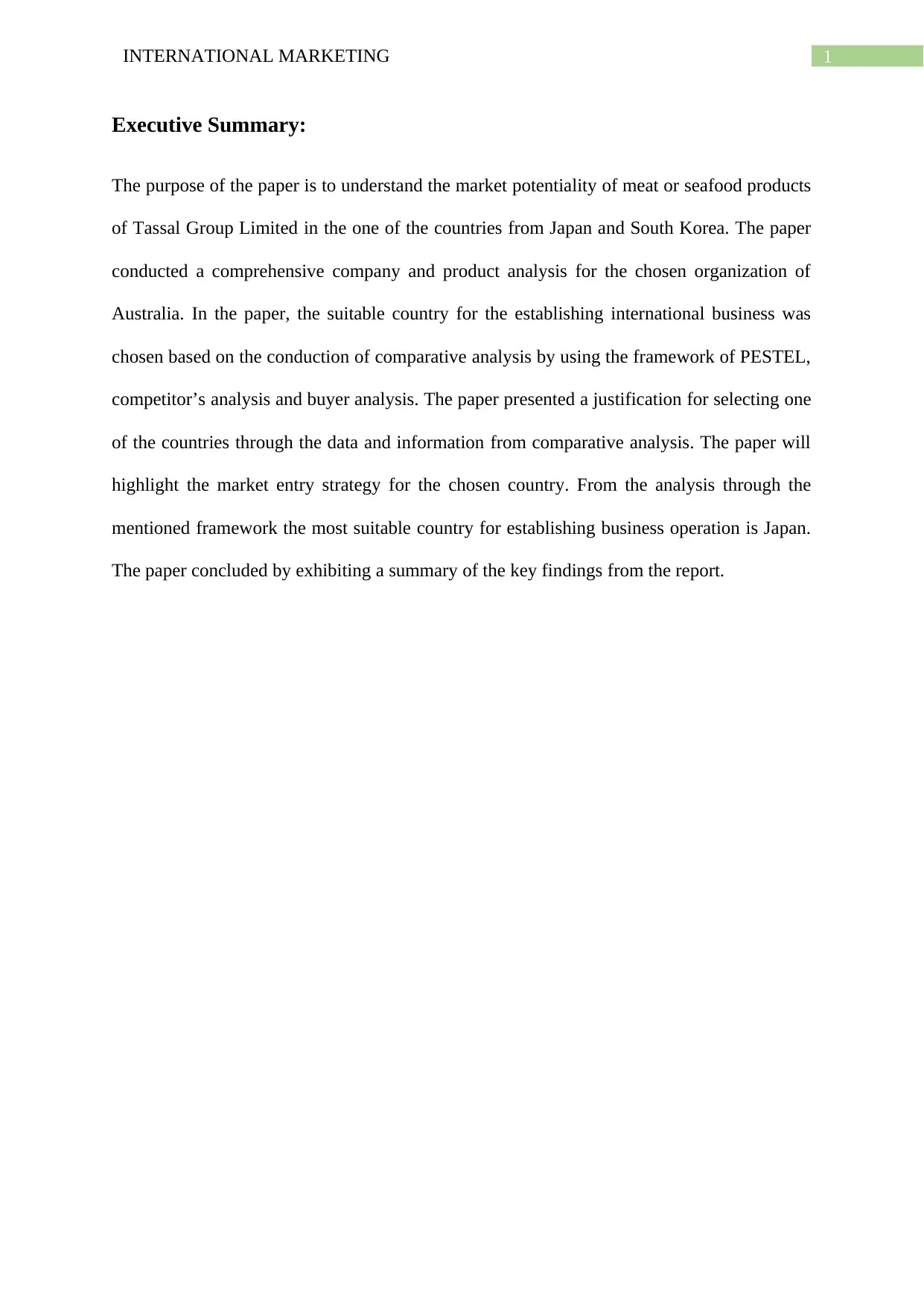
1INTERNATIONAL MARKETING
Executive Summary:
The purpose of the paper is to understand the market potentiality of meat or seafood products
of Tassal Group Limited in the one of the countries from Japan and South Korea. The paper
conducted a comprehensive company and product analysis for the chosen organization of
Australia. In the paper, the suitable country for the establishing international business was
chosen based on the conduction of comparative analysis by using the framework of PESTEL,
competitor’s analysis and buyer analysis. The paper presented a justification for selecting one
of the countries through the data and information from comparative analysis. The paper will
highlight the market entry strategy for the chosen country. From the analysis through the
mentioned framework the most suitable country for establishing business operation is Japan.
The paper concluded by exhibiting a summary of the key findings from the report.
Executive Summary:
The purpose of the paper is to understand the market potentiality of meat or seafood products
of Tassal Group Limited in the one of the countries from Japan and South Korea. The paper
conducted a comprehensive company and product analysis for the chosen organization of
Australia. In the paper, the suitable country for the establishing international business was
chosen based on the conduction of comparative analysis by using the framework of PESTEL,
competitor’s analysis and buyer analysis. The paper presented a justification for selecting one
of the countries through the data and information from comparative analysis. The paper will
highlight the market entry strategy for the chosen country. From the analysis through the
mentioned framework the most suitable country for establishing business operation is Japan.
The paper concluded by exhibiting a summary of the key findings from the report.
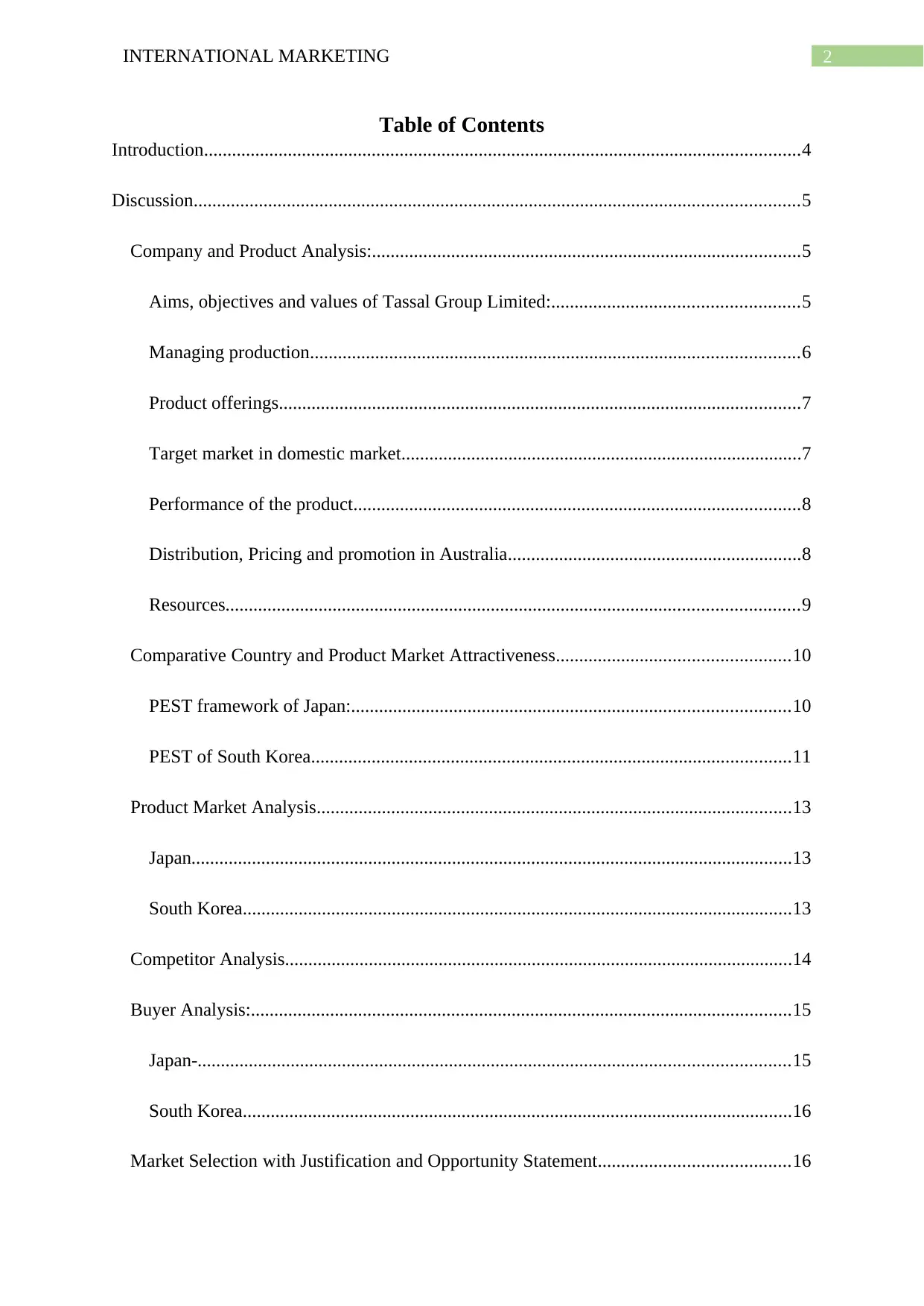
2INTERNATIONAL MARKETING
Table of Contents
Introduction................................................................................................................................4
Discussion..................................................................................................................................5
Company and Product Analysis:............................................................................................5
Aims, objectives and values of Tassal Group Limited:.....................................................5
Managing production.........................................................................................................6
Product offerings................................................................................................................7
Target market in domestic market......................................................................................7
Performance of the product................................................................................................8
Distribution, Pricing and promotion in Australia...............................................................8
Resources...........................................................................................................................9
Comparative Country and Product Market Attractiveness..................................................10
PEST framework of Japan:..............................................................................................10
PEST of South Korea.......................................................................................................11
Product Market Analysis......................................................................................................13
Japan.................................................................................................................................13
South Korea......................................................................................................................13
Competitor Analysis.............................................................................................................14
Buyer Analysis:....................................................................................................................15
Japan-...............................................................................................................................15
South Korea......................................................................................................................16
Market Selection with Justification and Opportunity Statement.........................................16
Table of Contents
Introduction................................................................................................................................4
Discussion..................................................................................................................................5
Company and Product Analysis:............................................................................................5
Aims, objectives and values of Tassal Group Limited:.....................................................5
Managing production.........................................................................................................6
Product offerings................................................................................................................7
Target market in domestic market......................................................................................7
Performance of the product................................................................................................8
Distribution, Pricing and promotion in Australia...............................................................8
Resources...........................................................................................................................9
Comparative Country and Product Market Attractiveness..................................................10
PEST framework of Japan:..............................................................................................10
PEST of South Korea.......................................................................................................11
Product Market Analysis......................................................................................................13
Japan.................................................................................................................................13
South Korea......................................................................................................................13
Competitor Analysis.............................................................................................................14
Buyer Analysis:....................................................................................................................15
Japan-...............................................................................................................................15
South Korea......................................................................................................................16
Market Selection with Justification and Opportunity Statement.........................................16
⊘ This is a preview!⊘
Do you want full access?
Subscribe today to unlock all pages.

Trusted by 1+ million students worldwide

3INTERNATIONAL MARKETING
Entry Strategy:.....................................................................................................................17
Conclusion................................................................................................................................17
Entry Strategy:.....................................................................................................................17
Conclusion................................................................................................................................17
Paraphrase This Document
Need a fresh take? Get an instant paraphrase of this document with our AI Paraphraser
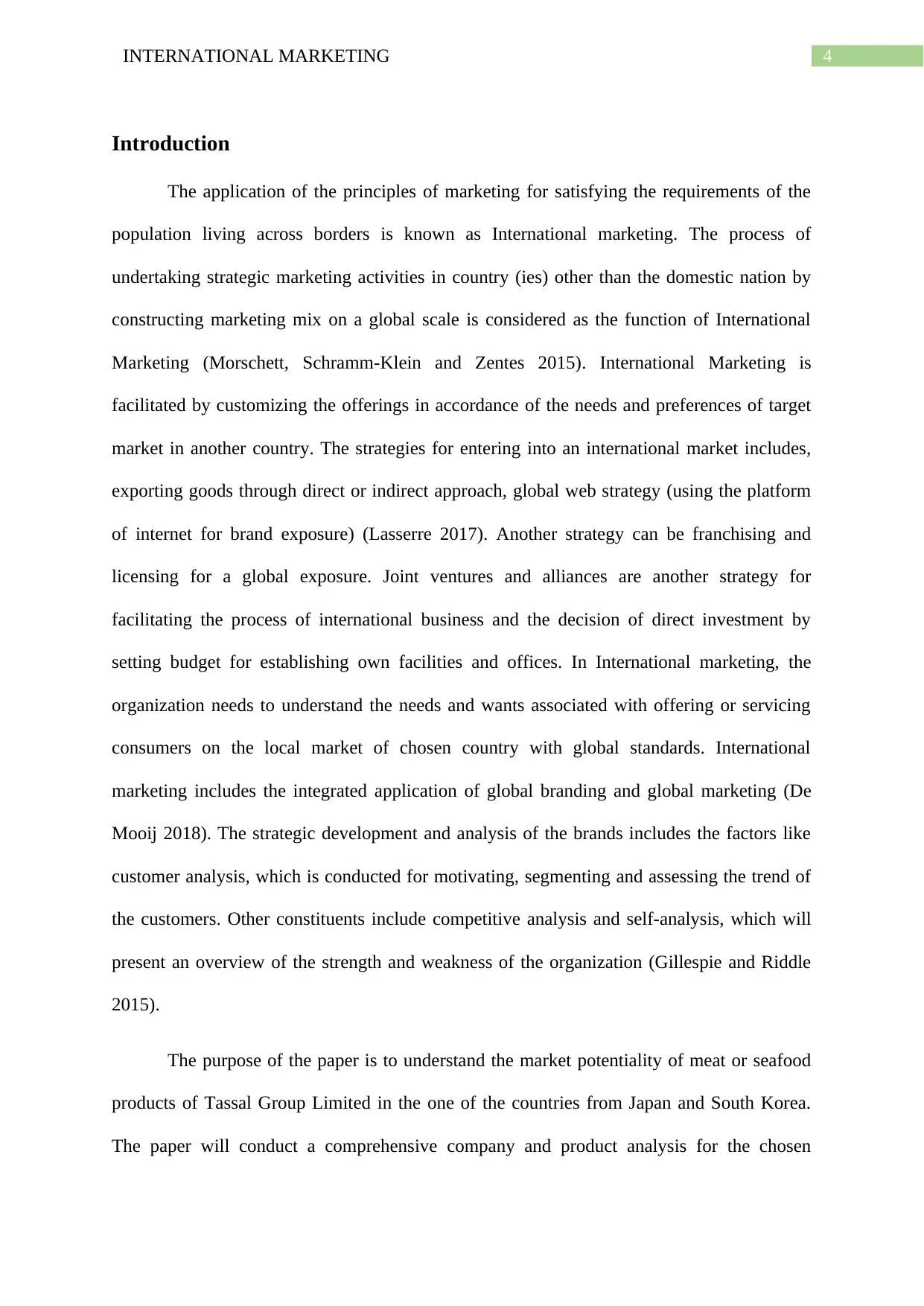
4INTERNATIONAL MARKETING
Introduction
The application of the principles of marketing for satisfying the requirements of the
population living across borders is known as International marketing. The process of
undertaking strategic marketing activities in country (ies) other than the domestic nation by
constructing marketing mix on a global scale is considered as the function of International
Marketing (Morschett, Schramm-Klein and Zentes 2015). International Marketing is
facilitated by customizing the offerings in accordance of the needs and preferences of target
market in another country. The strategies for entering into an international market includes,
exporting goods through direct or indirect approach, global web strategy (using the platform
of internet for brand exposure) (Lasserre 2017). Another strategy can be franchising and
licensing for a global exposure. Joint ventures and alliances are another strategy for
facilitating the process of international business and the decision of direct investment by
setting budget for establishing own facilities and offices. In International marketing, the
organization needs to understand the needs and wants associated with offering or servicing
consumers on the local market of chosen country with global standards. International
marketing includes the integrated application of global branding and global marketing (De
Mooij 2018). The strategic development and analysis of the brands includes the factors like
customer analysis, which is conducted for motivating, segmenting and assessing the trend of
the customers. Other constituents include competitive analysis and self-analysis, which will
present an overview of the strength and weakness of the organization (Gillespie and Riddle
2015).
The purpose of the paper is to understand the market potentiality of meat or seafood
products of Tassal Group Limited in the one of the countries from Japan and South Korea.
The paper will conduct a comprehensive company and product analysis for the chosen
Introduction
The application of the principles of marketing for satisfying the requirements of the
population living across borders is known as International marketing. The process of
undertaking strategic marketing activities in country (ies) other than the domestic nation by
constructing marketing mix on a global scale is considered as the function of International
Marketing (Morschett, Schramm-Klein and Zentes 2015). International Marketing is
facilitated by customizing the offerings in accordance of the needs and preferences of target
market in another country. The strategies for entering into an international market includes,
exporting goods through direct or indirect approach, global web strategy (using the platform
of internet for brand exposure) (Lasserre 2017). Another strategy can be franchising and
licensing for a global exposure. Joint ventures and alliances are another strategy for
facilitating the process of international business and the decision of direct investment by
setting budget for establishing own facilities and offices. In International marketing, the
organization needs to understand the needs and wants associated with offering or servicing
consumers on the local market of chosen country with global standards. International
marketing includes the integrated application of global branding and global marketing (De
Mooij 2018). The strategic development and analysis of the brands includes the factors like
customer analysis, which is conducted for motivating, segmenting and assessing the trend of
the customers. Other constituents include competitive analysis and self-analysis, which will
present an overview of the strength and weakness of the organization (Gillespie and Riddle
2015).
The purpose of the paper is to understand the market potentiality of meat or seafood
products of Tassal Group Limited in the one of the countries from Japan and South Korea.
The paper will conduct a comprehensive company and product analysis for the chosen
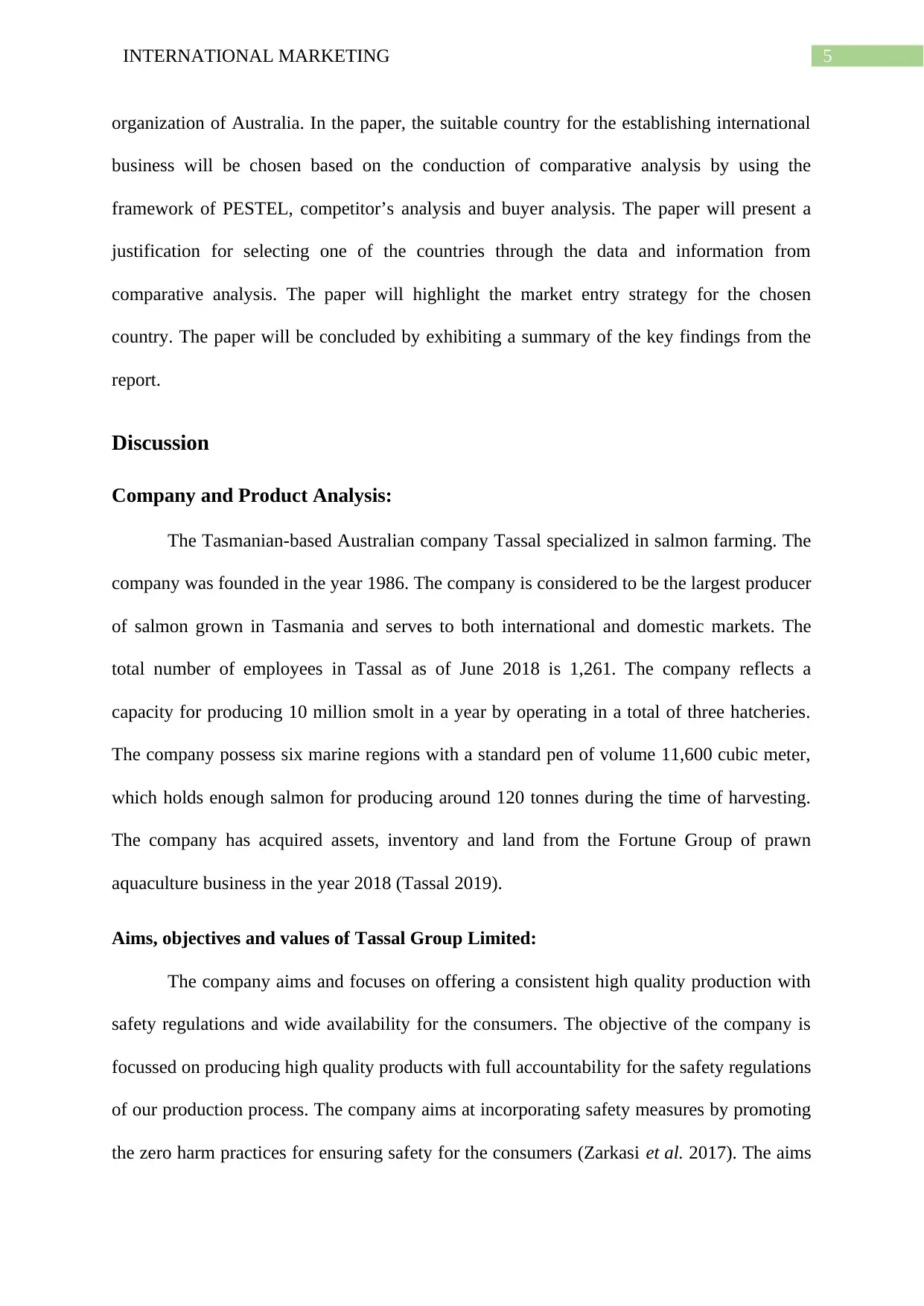
5INTERNATIONAL MARKETING
organization of Australia. In the paper, the suitable country for the establishing international
business will be chosen based on the conduction of comparative analysis by using the
framework of PESTEL, competitor’s analysis and buyer analysis. The paper will present a
justification for selecting one of the countries through the data and information from
comparative analysis. The paper will highlight the market entry strategy for the chosen
country. The paper will be concluded by exhibiting a summary of the key findings from the
report.
Discussion
Company and Product Analysis:
The Tasmanian-based Australian company Tassal specialized in salmon farming. The
company was founded in the year 1986. The company is considered to be the largest producer
of salmon grown in Tasmania and serves to both international and domestic markets. The
total number of employees in Tassal as of June 2018 is 1,261. The company reflects a
capacity for producing 10 million smolt in a year by operating in a total of three hatcheries.
The company possess six marine regions with a standard pen of volume 11,600 cubic meter,
which holds enough salmon for producing around 120 tonnes during the time of harvesting.
The company has acquired assets, inventory and land from the Fortune Group of prawn
aquaculture business in the year 2018 (Tassal 2019).
Aims, objectives and values of Tassal Group Limited:
The company aims and focuses on offering a consistent high quality production with
safety regulations and wide availability for the consumers. The objective of the company is
focussed on producing high quality products with full accountability for the safety regulations
of our production process. The company aims at incorporating safety measures by promoting
the zero harm practices for ensuring safety for the consumers (Zarkasi et al. 2017). The aims
organization of Australia. In the paper, the suitable country for the establishing international
business will be chosen based on the conduction of comparative analysis by using the
framework of PESTEL, competitor’s analysis and buyer analysis. The paper will present a
justification for selecting one of the countries through the data and information from
comparative analysis. The paper will highlight the market entry strategy for the chosen
country. The paper will be concluded by exhibiting a summary of the key findings from the
report.
Discussion
Company and Product Analysis:
The Tasmanian-based Australian company Tassal specialized in salmon farming. The
company was founded in the year 1986. The company is considered to be the largest producer
of salmon grown in Tasmania and serves to both international and domestic markets. The
total number of employees in Tassal as of June 2018 is 1,261. The company reflects a
capacity for producing 10 million smolt in a year by operating in a total of three hatcheries.
The company possess six marine regions with a standard pen of volume 11,600 cubic meter,
which holds enough salmon for producing around 120 tonnes during the time of harvesting.
The company has acquired assets, inventory and land from the Fortune Group of prawn
aquaculture business in the year 2018 (Tassal 2019).
Aims, objectives and values of Tassal Group Limited:
The company aims and focuses on offering a consistent high quality production with
safety regulations and wide availability for the consumers. The objective of the company is
focussed on producing high quality products with full accountability for the safety regulations
of our production process. The company aims at incorporating safety measures by promoting
the zero harm practices for ensuring safety for the consumers (Zarkasi et al. 2017). The aims
⊘ This is a preview!⊘
Do you want full access?
Subscribe today to unlock all pages.

Trusted by 1+ million students worldwide
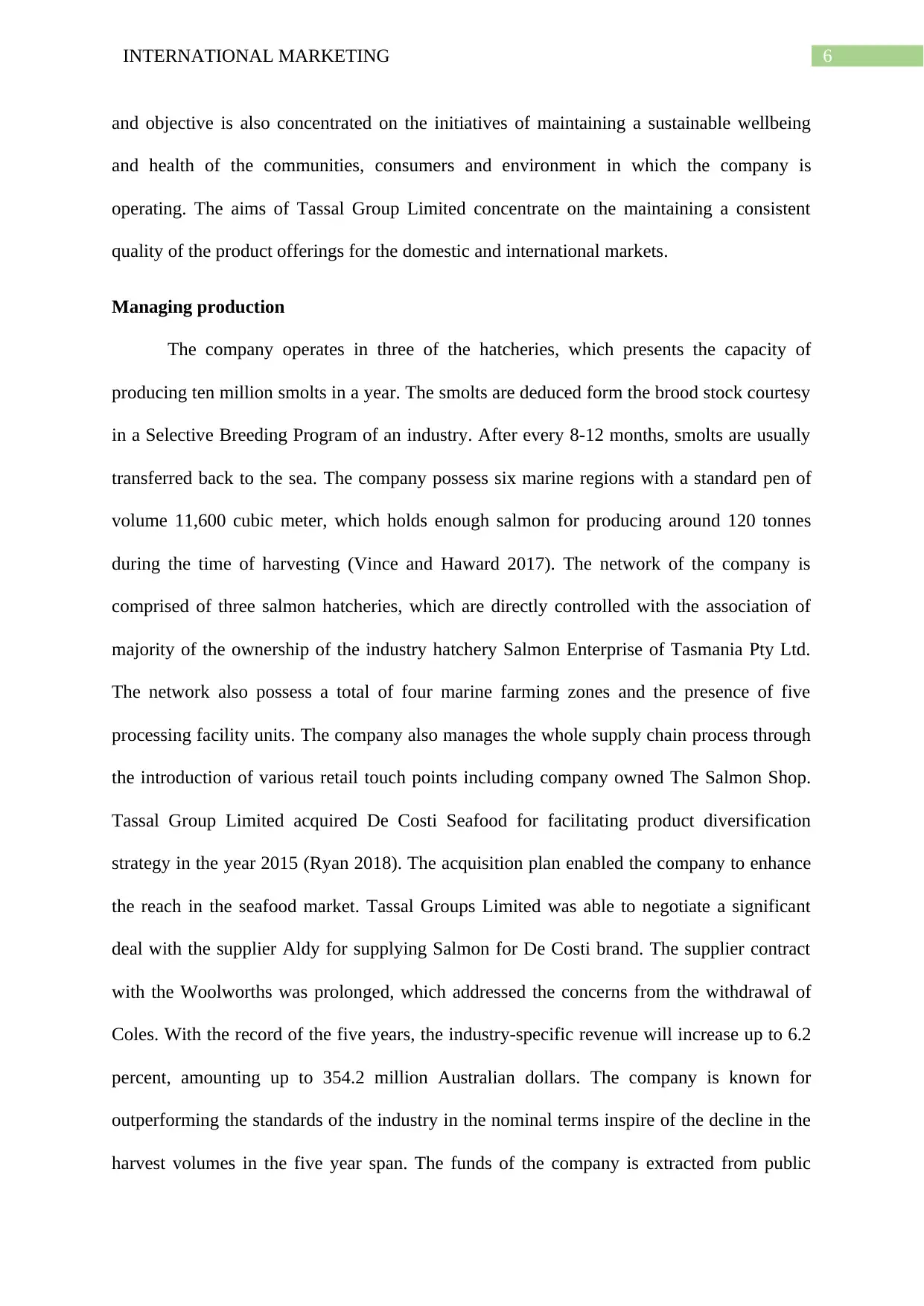
6INTERNATIONAL MARKETING
and objective is also concentrated on the initiatives of maintaining a sustainable wellbeing
and health of the communities, consumers and environment in which the company is
operating. The aims of Tassal Group Limited concentrate on the maintaining a consistent
quality of the product offerings for the domestic and international markets.
Managing production
The company operates in three of the hatcheries, which presents the capacity of
producing ten million smolts in a year. The smolts are deduced form the brood stock courtesy
in a Selective Breeding Program of an industry. After every 8-12 months, smolts are usually
transferred back to the sea. The company possess six marine regions with a standard pen of
volume 11,600 cubic meter, which holds enough salmon for producing around 120 tonnes
during the time of harvesting (Vince and Haward 2017). The network of the company is
comprised of three salmon hatcheries, which are directly controlled with the association of
majority of the ownership of the industry hatchery Salmon Enterprise of Tasmania Pty Ltd.
The network also possess a total of four marine farming zones and the presence of five
processing facility units. The company also manages the whole supply chain process through
the introduction of various retail touch points including company owned The Salmon Shop.
Tassal Group Limited acquired De Costi Seafood for facilitating product diversification
strategy in the year 2015 (Ryan 2018). The acquisition plan enabled the company to enhance
the reach in the seafood market. Tassal Groups Limited was able to negotiate a significant
deal with the supplier Aldy for supplying Salmon for De Costi brand. The supplier contract
with the Woolworths was prolonged, which addressed the concerns from the withdrawal of
Coles. With the record of the five years, the industry-specific revenue will increase up to 6.2
percent, amounting up to 354.2 million Australian dollars. The company is known for
outperforming the standards of the industry in the nominal terms inspire of the decline in the
harvest volumes in the five year span. The funds of the company is extracted from public
and objective is also concentrated on the initiatives of maintaining a sustainable wellbeing
and health of the communities, consumers and environment in which the company is
operating. The aims of Tassal Group Limited concentrate on the maintaining a consistent
quality of the product offerings for the domestic and international markets.
Managing production
The company operates in three of the hatcheries, which presents the capacity of
producing ten million smolts in a year. The smolts are deduced form the brood stock courtesy
in a Selective Breeding Program of an industry. After every 8-12 months, smolts are usually
transferred back to the sea. The company possess six marine regions with a standard pen of
volume 11,600 cubic meter, which holds enough salmon for producing around 120 tonnes
during the time of harvesting (Vince and Haward 2017). The network of the company is
comprised of three salmon hatcheries, which are directly controlled with the association of
majority of the ownership of the industry hatchery Salmon Enterprise of Tasmania Pty Ltd.
The network also possess a total of four marine farming zones and the presence of five
processing facility units. The company also manages the whole supply chain process through
the introduction of various retail touch points including company owned The Salmon Shop.
Tassal Group Limited acquired De Costi Seafood for facilitating product diversification
strategy in the year 2015 (Ryan 2018). The acquisition plan enabled the company to enhance
the reach in the seafood market. Tassal Groups Limited was able to negotiate a significant
deal with the supplier Aldy for supplying Salmon for De Costi brand. The supplier contract
with the Woolworths was prolonged, which addressed the concerns from the withdrawal of
Coles. With the record of the five years, the industry-specific revenue will increase up to 6.2
percent, amounting up to 354.2 million Australian dollars. The company is known for
outperforming the standards of the industry in the nominal terms inspire of the decline in the
harvest volumes in the five year span. The funds of the company is extracted from public
Paraphrase This Document
Need a fresh take? Get an instant paraphrase of this document with our AI Paraphraser
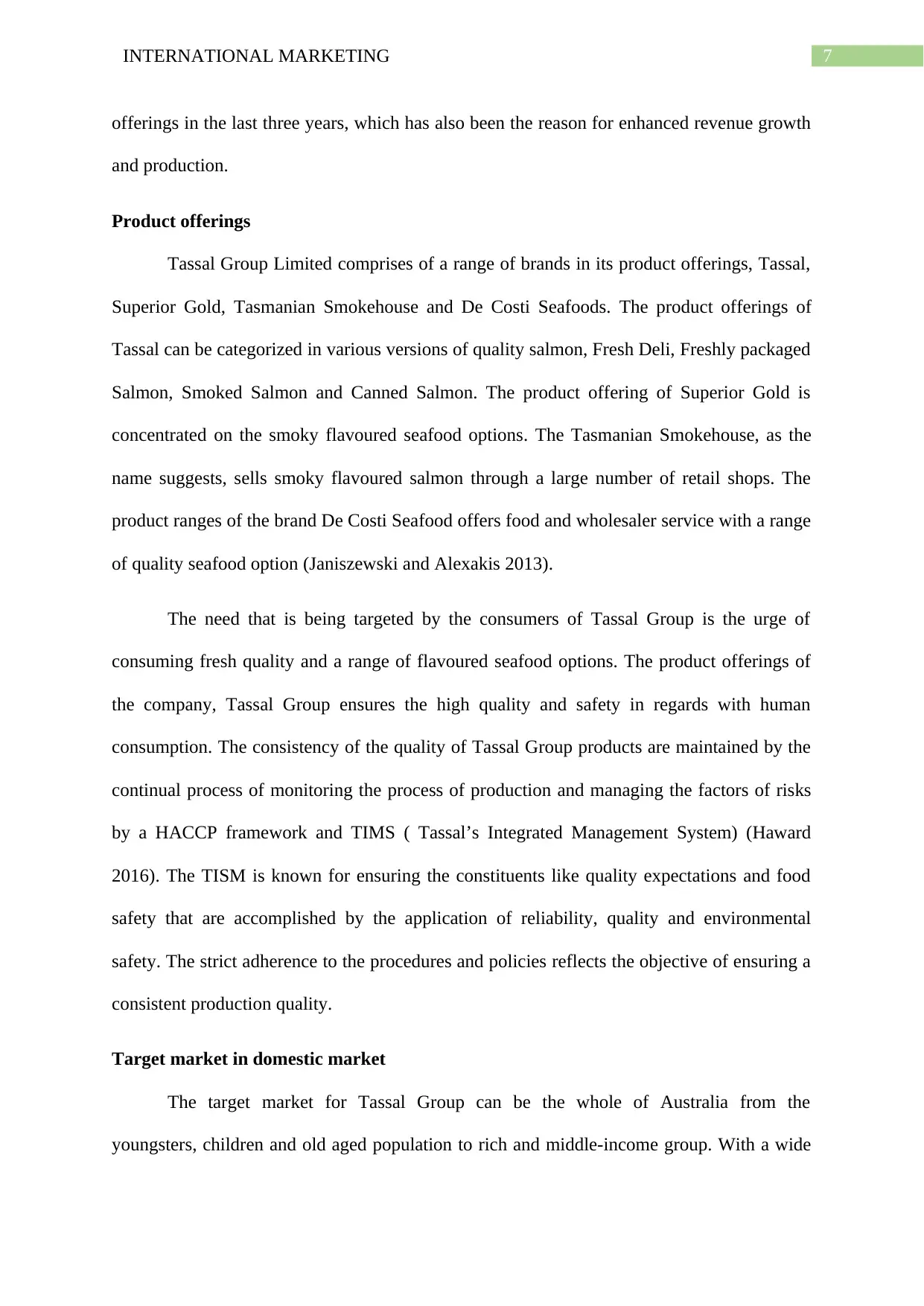
7INTERNATIONAL MARKETING
offerings in the last three years, which has also been the reason for enhanced revenue growth
and production.
Product offerings
Tassal Group Limited comprises of a range of brands in its product offerings, Tassal,
Superior Gold, Tasmanian Smokehouse and De Costi Seafoods. The product offerings of
Tassal can be categorized in various versions of quality salmon, Fresh Deli, Freshly packaged
Salmon, Smoked Salmon and Canned Salmon. The product offering of Superior Gold is
concentrated on the smoky flavoured seafood options. The Tasmanian Smokehouse, as the
name suggests, sells smoky flavoured salmon through a large number of retail shops. The
product ranges of the brand De Costi Seafood offers food and wholesaler service with a range
of quality seafood option (Janiszewski and Alexakis 2013).
The need that is being targeted by the consumers of Tassal Group is the urge of
consuming fresh quality and a range of flavoured seafood options. The product offerings of
the company, Tassal Group ensures the high quality and safety in regards with human
consumption. The consistency of the quality of Tassal Group products are maintained by the
continual process of monitoring the process of production and managing the factors of risks
by a HACCP framework and TIMS ( Tassal’s Integrated Management System) (Haward
2016). The TISM is known for ensuring the constituents like quality expectations and food
safety that are accomplished by the application of reliability, quality and environmental
safety. The strict adherence to the procedures and policies reflects the objective of ensuring a
consistent production quality.
Target market in domestic market
The target market for Tassal Group can be the whole of Australia from the
youngsters, children and old aged population to rich and middle-income group. With a wide
offerings in the last three years, which has also been the reason for enhanced revenue growth
and production.
Product offerings
Tassal Group Limited comprises of a range of brands in its product offerings, Tassal,
Superior Gold, Tasmanian Smokehouse and De Costi Seafoods. The product offerings of
Tassal can be categorized in various versions of quality salmon, Fresh Deli, Freshly packaged
Salmon, Smoked Salmon and Canned Salmon. The product offering of Superior Gold is
concentrated on the smoky flavoured seafood options. The Tasmanian Smokehouse, as the
name suggests, sells smoky flavoured salmon through a large number of retail shops. The
product ranges of the brand De Costi Seafood offers food and wholesaler service with a range
of quality seafood option (Janiszewski and Alexakis 2013).
The need that is being targeted by the consumers of Tassal Group is the urge of
consuming fresh quality and a range of flavoured seafood options. The product offerings of
the company, Tassal Group ensures the high quality and safety in regards with human
consumption. The consistency of the quality of Tassal Group products are maintained by the
continual process of monitoring the process of production and managing the factors of risks
by a HACCP framework and TIMS ( Tassal’s Integrated Management System) (Haward
2016). The TISM is known for ensuring the constituents like quality expectations and food
safety that are accomplished by the application of reliability, quality and environmental
safety. The strict adherence to the procedures and policies reflects the objective of ensuring a
consistent production quality.
Target market in domestic market
The target market for Tassal Group can be the whole of Australia from the
youngsters, children and old aged population to rich and middle-income group. With a wide
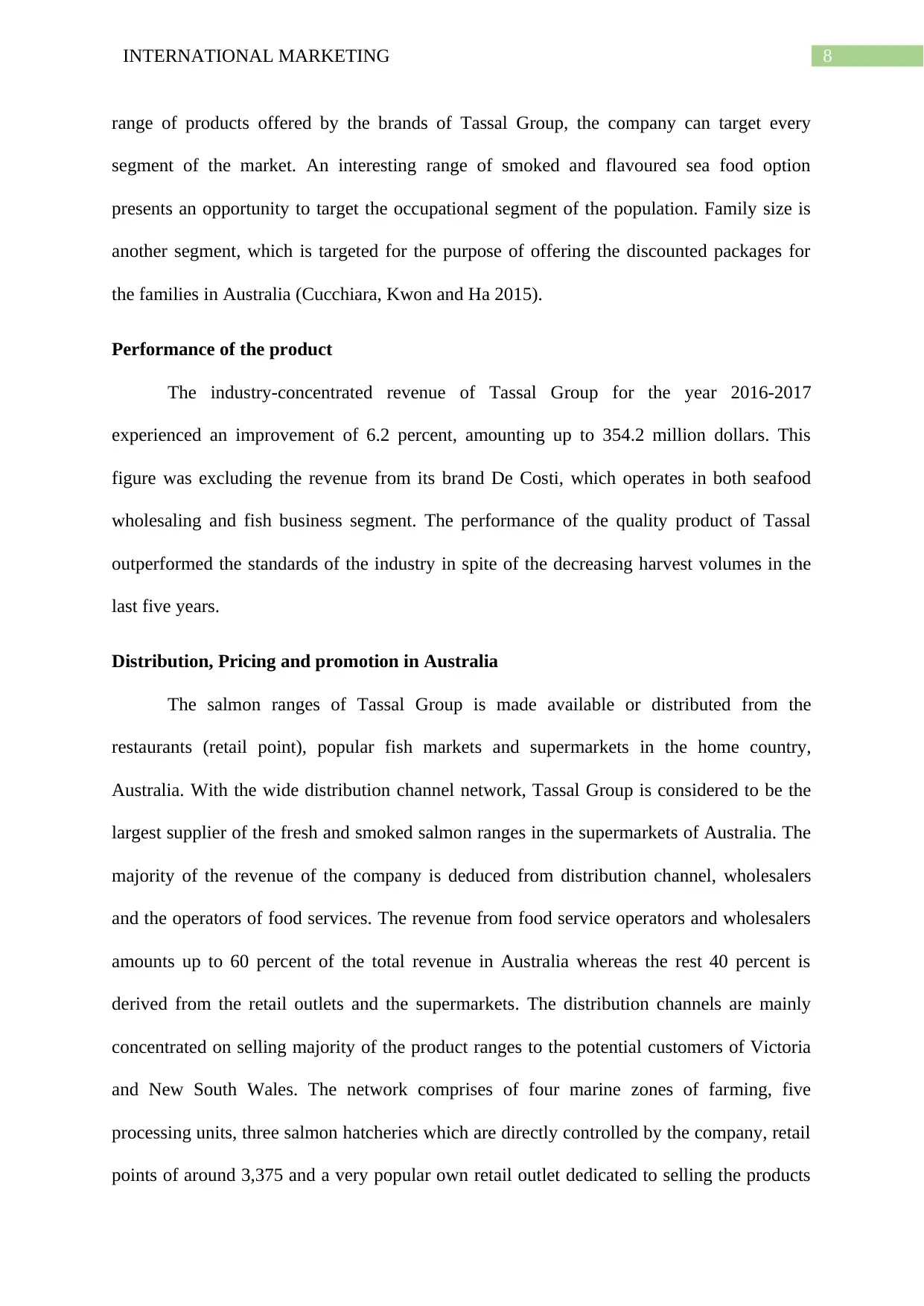
8INTERNATIONAL MARKETING
range of products offered by the brands of Tassal Group, the company can target every
segment of the market. An interesting range of smoked and flavoured sea food option
presents an opportunity to target the occupational segment of the population. Family size is
another segment, which is targeted for the purpose of offering the discounted packages for
the families in Australia (Cucchiara, Kwon and Ha 2015).
Performance of the product
The industry-concentrated revenue of Tassal Group for the year 2016-2017
experienced an improvement of 6.2 percent, amounting up to 354.2 million dollars. This
figure was excluding the revenue from its brand De Costi, which operates in both seafood
wholesaling and fish business segment. The performance of the quality product of Tassal
outperformed the standards of the industry in spite of the decreasing harvest volumes in the
last five years.
Distribution, Pricing and promotion in Australia
The salmon ranges of Tassal Group is made available or distributed from the
restaurants (retail point), popular fish markets and supermarkets in the home country,
Australia. With the wide distribution channel network, Tassal Group is considered to be the
largest supplier of the fresh and smoked salmon ranges in the supermarkets of Australia. The
majority of the revenue of the company is deduced from distribution channel, wholesalers
and the operators of food services. The revenue from food service operators and wholesalers
amounts up to 60 percent of the total revenue in Australia whereas the rest 40 percent is
derived from the retail outlets and the supermarkets. The distribution channels are mainly
concentrated on selling majority of the product ranges to the potential customers of Victoria
and New South Wales. The network comprises of four marine zones of farming, five
processing units, three salmon hatcheries which are directly controlled by the company, retail
points of around 3,375 and a very popular own retail outlet dedicated to selling the products
range of products offered by the brands of Tassal Group, the company can target every
segment of the market. An interesting range of smoked and flavoured sea food option
presents an opportunity to target the occupational segment of the population. Family size is
another segment, which is targeted for the purpose of offering the discounted packages for
the families in Australia (Cucchiara, Kwon and Ha 2015).
Performance of the product
The industry-concentrated revenue of Tassal Group for the year 2016-2017
experienced an improvement of 6.2 percent, amounting up to 354.2 million dollars. This
figure was excluding the revenue from its brand De Costi, which operates in both seafood
wholesaling and fish business segment. The performance of the quality product of Tassal
outperformed the standards of the industry in spite of the decreasing harvest volumes in the
last five years.
Distribution, Pricing and promotion in Australia
The salmon ranges of Tassal Group is made available or distributed from the
restaurants (retail point), popular fish markets and supermarkets in the home country,
Australia. With the wide distribution channel network, Tassal Group is considered to be the
largest supplier of the fresh and smoked salmon ranges in the supermarkets of Australia. The
majority of the revenue of the company is deduced from distribution channel, wholesalers
and the operators of food services. The revenue from food service operators and wholesalers
amounts up to 60 percent of the total revenue in Australia whereas the rest 40 percent is
derived from the retail outlets and the supermarkets. The distribution channels are mainly
concentrated on selling majority of the product ranges to the potential customers of Victoria
and New South Wales. The network comprises of four marine zones of farming, five
processing units, three salmon hatcheries which are directly controlled by the company, retail
points of around 3,375 and a very popular own retail outlet dedicated to selling the products
⊘ This is a preview!⊘
Do you want full access?
Subscribe today to unlock all pages.

Trusted by 1+ million students worldwide
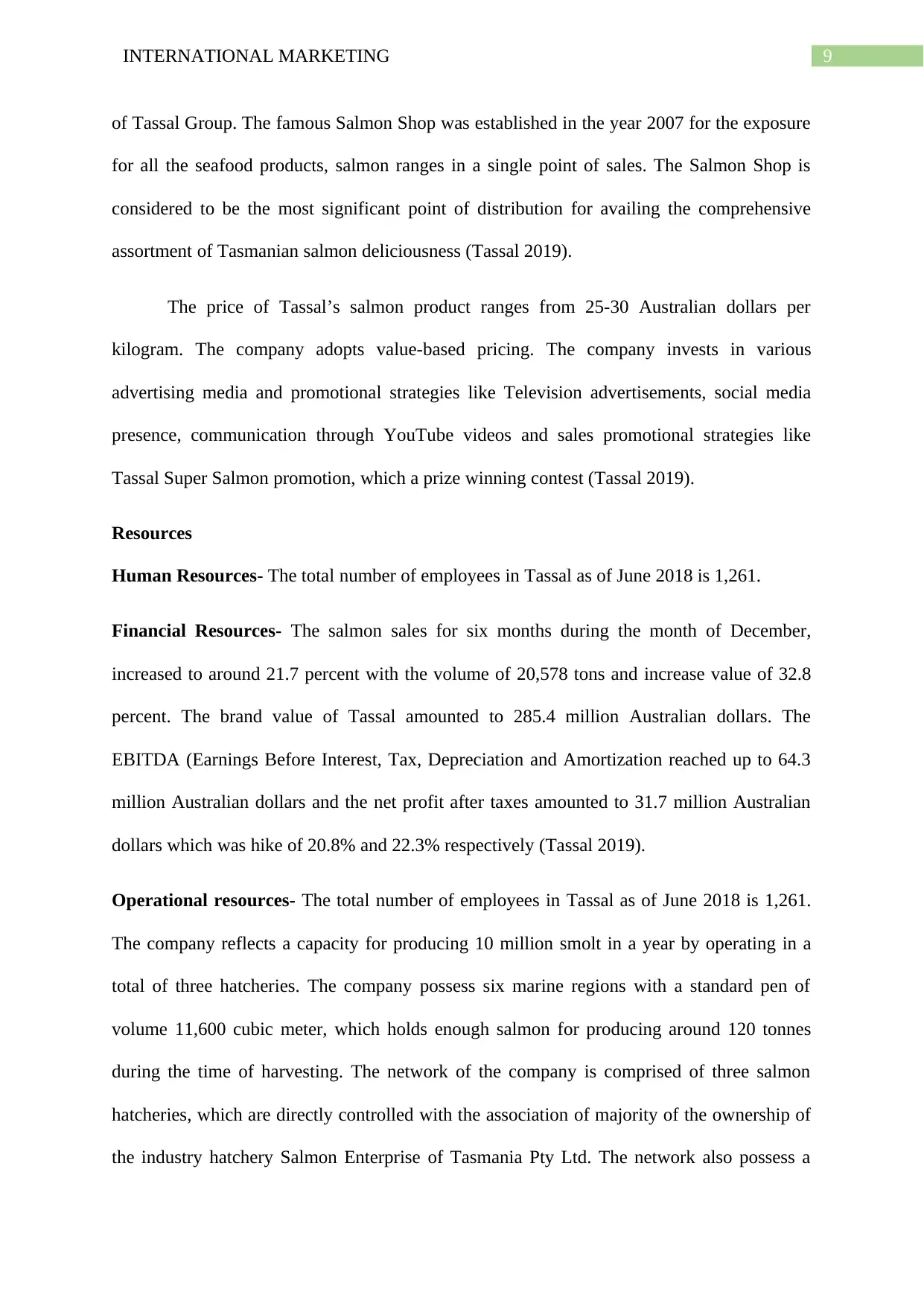
9INTERNATIONAL MARKETING
of Tassal Group. The famous Salmon Shop was established in the year 2007 for the exposure
for all the seafood products, salmon ranges in a single point of sales. The Salmon Shop is
considered to be the most significant point of distribution for availing the comprehensive
assortment of Tasmanian salmon deliciousness (Tassal 2019).
The price of Tassal’s salmon product ranges from 25-30 Australian dollars per
kilogram. The company adopts value-based pricing. The company invests in various
advertising media and promotional strategies like Television advertisements, social media
presence, communication through YouTube videos and sales promotional strategies like
Tassal Super Salmon promotion, which a prize winning contest (Tassal 2019).
Resources
Human Resources- The total number of employees in Tassal as of June 2018 is 1,261.
Financial Resources- The salmon sales for six months during the month of December,
increased to around 21.7 percent with the volume of 20,578 tons and increase value of 32.8
percent. The brand value of Tassal amounted to 285.4 million Australian dollars. The
EBITDA (Earnings Before Interest, Tax, Depreciation and Amortization reached up to 64.3
million Australian dollars and the net profit after taxes amounted to 31.7 million Australian
dollars which was hike of 20.8% and 22.3% respectively (Tassal 2019).
Operational resources- The total number of employees in Tassal as of June 2018 is 1,261.
The company reflects a capacity for producing 10 million smolt in a year by operating in a
total of three hatcheries. The company possess six marine regions with a standard pen of
volume 11,600 cubic meter, which holds enough salmon for producing around 120 tonnes
during the time of harvesting. The network of the company is comprised of three salmon
hatcheries, which are directly controlled with the association of majority of the ownership of
the industry hatchery Salmon Enterprise of Tasmania Pty Ltd. The network also possess a
of Tassal Group. The famous Salmon Shop was established in the year 2007 for the exposure
for all the seafood products, salmon ranges in a single point of sales. The Salmon Shop is
considered to be the most significant point of distribution for availing the comprehensive
assortment of Tasmanian salmon deliciousness (Tassal 2019).
The price of Tassal’s salmon product ranges from 25-30 Australian dollars per
kilogram. The company adopts value-based pricing. The company invests in various
advertising media and promotional strategies like Television advertisements, social media
presence, communication through YouTube videos and sales promotional strategies like
Tassal Super Salmon promotion, which a prize winning contest (Tassal 2019).
Resources
Human Resources- The total number of employees in Tassal as of June 2018 is 1,261.
Financial Resources- The salmon sales for six months during the month of December,
increased to around 21.7 percent with the volume of 20,578 tons and increase value of 32.8
percent. The brand value of Tassal amounted to 285.4 million Australian dollars. The
EBITDA (Earnings Before Interest, Tax, Depreciation and Amortization reached up to 64.3
million Australian dollars and the net profit after taxes amounted to 31.7 million Australian
dollars which was hike of 20.8% and 22.3% respectively (Tassal 2019).
Operational resources- The total number of employees in Tassal as of June 2018 is 1,261.
The company reflects a capacity for producing 10 million smolt in a year by operating in a
total of three hatcheries. The company possess six marine regions with a standard pen of
volume 11,600 cubic meter, which holds enough salmon for producing around 120 tonnes
during the time of harvesting. The network of the company is comprised of three salmon
hatcheries, which are directly controlled with the association of majority of the ownership of
the industry hatchery Salmon Enterprise of Tasmania Pty Ltd. The network also possess a
Paraphrase This Document
Need a fresh take? Get an instant paraphrase of this document with our AI Paraphraser
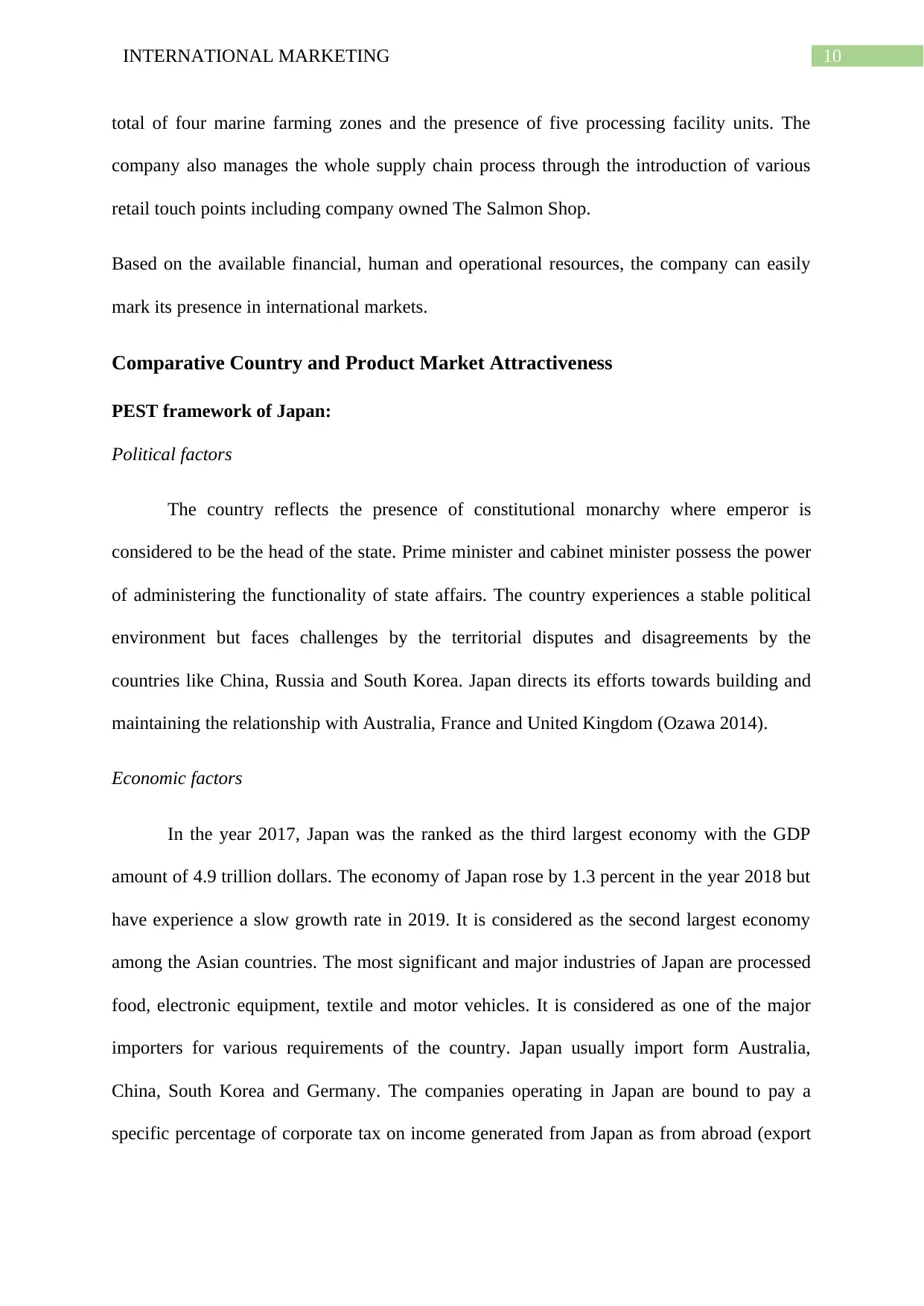
10INTERNATIONAL MARKETING
total of four marine farming zones and the presence of five processing facility units. The
company also manages the whole supply chain process through the introduction of various
retail touch points including company owned The Salmon Shop.
Based on the available financial, human and operational resources, the company can easily
mark its presence in international markets.
Comparative Country and Product Market Attractiveness
PEST framework of Japan:
Political factors
The country reflects the presence of constitutional monarchy where emperor is
considered to be the head of the state. Prime minister and cabinet minister possess the power
of administering the functionality of state affairs. The country experiences a stable political
environment but faces challenges by the territorial disputes and disagreements by the
countries like China, Russia and South Korea. Japan directs its efforts towards building and
maintaining the relationship with Australia, France and United Kingdom (Ozawa 2014).
Economic factors
In the year 2017, Japan was the ranked as the third largest economy with the GDP
amount of 4.9 trillion dollars. The economy of Japan rose by 1.3 percent in the year 2018 but
have experience a slow growth rate in 2019. It is considered as the second largest economy
among the Asian countries. The most significant and major industries of Japan are processed
food, electronic equipment, textile and motor vehicles. It is considered as one of the major
importers for various requirements of the country. Japan usually import form Australia,
China, South Korea and Germany. The companies operating in Japan are bound to pay a
specific percentage of corporate tax on income generated from Japan as from abroad (export
total of four marine farming zones and the presence of five processing facility units. The
company also manages the whole supply chain process through the introduction of various
retail touch points including company owned The Salmon Shop.
Based on the available financial, human and operational resources, the company can easily
mark its presence in international markets.
Comparative Country and Product Market Attractiveness
PEST framework of Japan:
Political factors
The country reflects the presence of constitutional monarchy where emperor is
considered to be the head of the state. Prime minister and cabinet minister possess the power
of administering the functionality of state affairs. The country experiences a stable political
environment but faces challenges by the territorial disputes and disagreements by the
countries like China, Russia and South Korea. Japan directs its efforts towards building and
maintaining the relationship with Australia, France and United Kingdom (Ozawa 2014).
Economic factors
In the year 2017, Japan was the ranked as the third largest economy with the GDP
amount of 4.9 trillion dollars. The economy of Japan rose by 1.3 percent in the year 2018 but
have experience a slow growth rate in 2019. It is considered as the second largest economy
among the Asian countries. The most significant and major industries of Japan are processed
food, electronic equipment, textile and motor vehicles. It is considered as one of the major
importers for various requirements of the country. Japan usually import form Australia,
China, South Korea and Germany. The companies operating in Japan are bound to pay a
specific percentage of corporate tax on income generated from Japan as from abroad (export
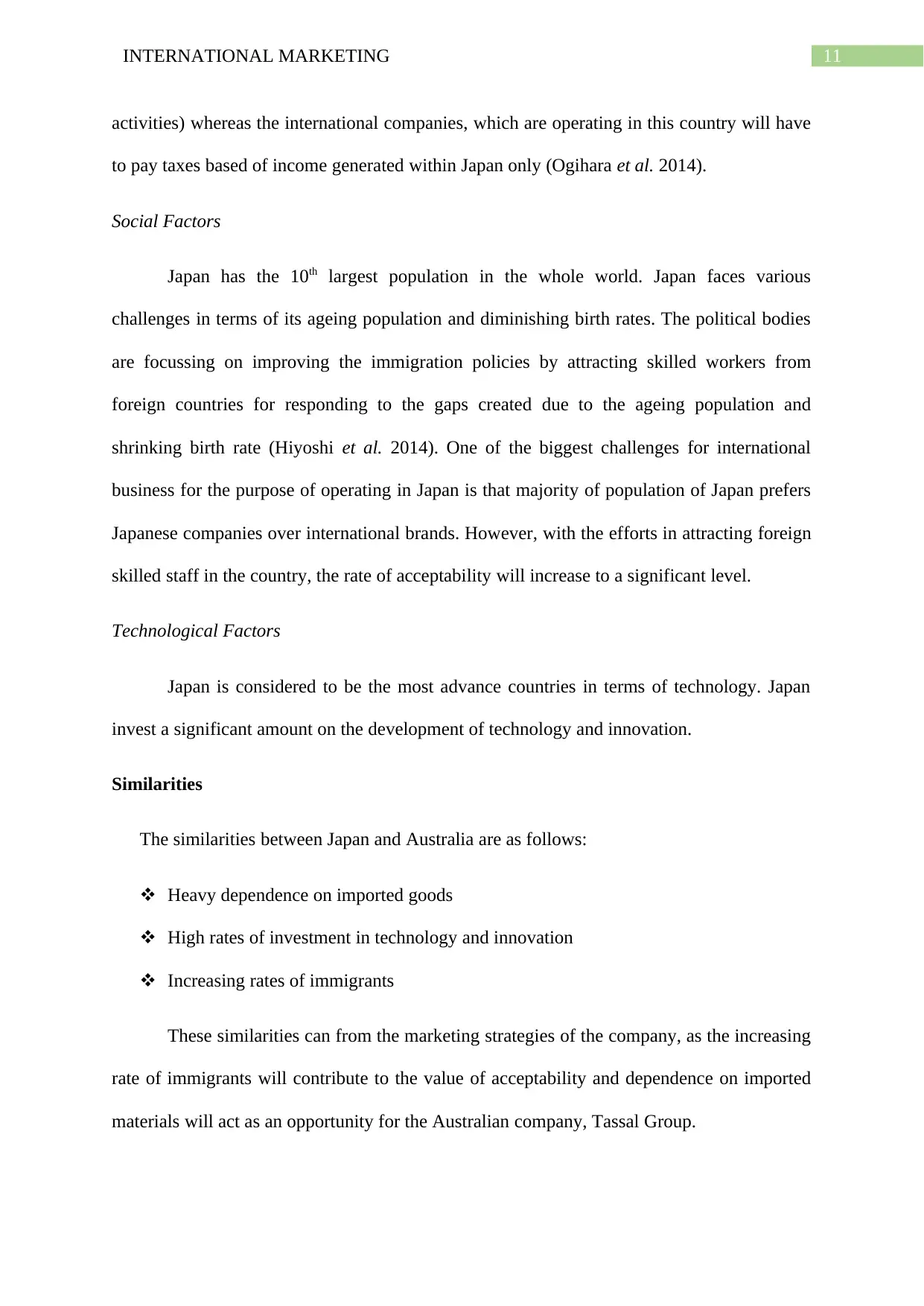
11INTERNATIONAL MARKETING
activities) whereas the international companies, which are operating in this country will have
to pay taxes based of income generated within Japan only (Ogihara et al. 2014).
Social Factors
Japan has the 10th largest population in the whole world. Japan faces various
challenges in terms of its ageing population and diminishing birth rates. The political bodies
are focussing on improving the immigration policies by attracting skilled workers from
foreign countries for responding to the gaps created due to the ageing population and
shrinking birth rate (Hiyoshi et al. 2014). One of the biggest challenges for international
business for the purpose of operating in Japan is that majority of population of Japan prefers
Japanese companies over international brands. However, with the efforts in attracting foreign
skilled staff in the country, the rate of acceptability will increase to a significant level.
Technological Factors
Japan is considered to be the most advance countries in terms of technology. Japan
invest a significant amount on the development of technology and innovation.
Similarities
The similarities between Japan and Australia are as follows:
Heavy dependence on imported goods
High rates of investment in technology and innovation
Increasing rates of immigrants
These similarities can from the marketing strategies of the company, as the increasing
rate of immigrants will contribute to the value of acceptability and dependence on imported
materials will act as an opportunity for the Australian company, Tassal Group.
activities) whereas the international companies, which are operating in this country will have
to pay taxes based of income generated within Japan only (Ogihara et al. 2014).
Social Factors
Japan has the 10th largest population in the whole world. Japan faces various
challenges in terms of its ageing population and diminishing birth rates. The political bodies
are focussing on improving the immigration policies by attracting skilled workers from
foreign countries for responding to the gaps created due to the ageing population and
shrinking birth rate (Hiyoshi et al. 2014). One of the biggest challenges for international
business for the purpose of operating in Japan is that majority of population of Japan prefers
Japanese companies over international brands. However, with the efforts in attracting foreign
skilled staff in the country, the rate of acceptability will increase to a significant level.
Technological Factors
Japan is considered to be the most advance countries in terms of technology. Japan
invest a significant amount on the development of technology and innovation.
Similarities
The similarities between Japan and Australia are as follows:
Heavy dependence on imported goods
High rates of investment in technology and innovation
Increasing rates of immigrants
These similarities can from the marketing strategies of the company, as the increasing
rate of immigrants will contribute to the value of acceptability and dependence on imported
materials will act as an opportunity for the Australian company, Tassal Group.
⊘ This is a preview!⊘
Do you want full access?
Subscribe today to unlock all pages.

Trusted by 1+ million students worldwide
1 out of 22
Related Documents
Your All-in-One AI-Powered Toolkit for Academic Success.
+13062052269
info@desklib.com
Available 24*7 on WhatsApp / Email
![[object Object]](/_next/static/media/star-bottom.7253800d.svg)
Unlock your academic potential
Copyright © 2020–2025 A2Z Services. All Rights Reserved. Developed and managed by ZUCOL.





